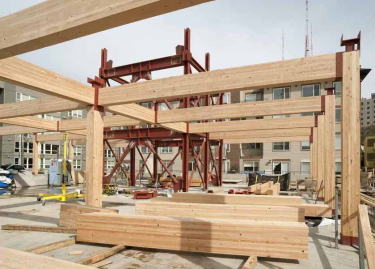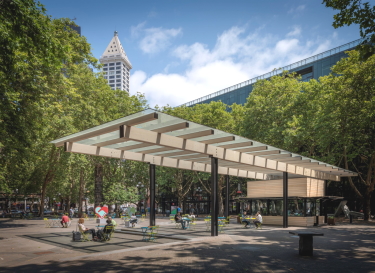|
Subscribe / Renew |
|
|
Contact Us |
|
| ► Subscribe to our Free Weekly Newsletter | |
| home | Welcome, sign in or click here to subscribe. | login |
Construction
| |

April 28, 2022
Beyond the horizon: Steering Ship Lofts toward a sustainable future in Tacoma
Schuchart Construction
Behind every Living Building is an ambitious vision, an integrated design approach coordinated across all disciplines, and a team committed to making that vision a reality. But a building that meets the world's most rigorous performance standards also requires a team well versed in green building practices, with deep technical knowledge of sustainable design and construction solutions, and the ability to think holistically about how to achieve certification requirements.
The Living Building Challenge consists of seven performance “petals”: place, water, energy, health and happiness, materials, equity, and beauty. Each petal is subdivided into a set of imperatives that are applied based on project type; to receive full certification all required imperatives must be met. With the goal of working toward a truly regenerative living future, the program is regularly evolving to reflect new discoveries and technology; continually raising the bar for sustainable, performance-based design and construction.
THE IMPORTANCE OF THE MATERIALS PETAL
Perhaps the most representative of this iterative philosophy is the materials petal. As Abby Bartlett, one of Schuchart's Living Building Challenge certification gurus notes, “The materials petal is designed to promote greener construction products and inspire manufacturers to embrace a more sustainable materials market. It's positioned to have the biggest impact on future sustainability measures and standards.”

As design and construction teams continue to explore new, more eco-friendly solutions, sustainable building materials continue to evolve. We're no longer limited to traditional products like concrete, brick and steel; natural wood, bamboo and cork are now viable options, and the list keeps growing.
As inspiring as the materials petal is, it can also be intimidating. The imperatives present strict requirements that improve transparency around how products are obtained and produced, and eliminate the use of materials that have negative environmental, health and social impacts. Materials must be sustainably sourced or repurposed, and come from within a certain distance from the project site. Wood must be FSC certified. Red List materials must be avoided, and the project's total embodied carbon impacts must be measured and recorded.
It can seem daunting, but a team committed to contributing to a healthier, more sustainable future will be up for the challenge.
MATERIALS, PERFORMANCE GO HAND IN HAND
When planning any construction project, you need a clear vision of how the volume of the space will be built and supported. For a project pursuing Living Building certification, this is a critical first step that must go hand in hand with performance requirements and involve the entire team in the conversation. A rooftop rainwater collection system will help achieve net-zero water, but how does the infrastructure tie into the rest of the building? Large windows will provide residential views, but how do you balance them with energy performance requirements? If the majority of the exterior will be glass, it must be triple paned to meet energy code. How will that weight be supported?
Everyone involved in materials selection needs to understand the project goals and work together to find solutions that holistically address the Living Building Challenge performance requirements.
SHOWCASING SUSTAINABLE STRATEGIES
Sustainable materials selection and inspiring design don't have to be mutually exclusive; this is particularly true for a Living Building project. When aiming for such high levels of sustainability and efficiency, there's a degree of honesty and transparency that people want and expect. Sustainable strategies should be front and center, serving to educate and encourage a more eco-friendly lifestyle. And when it comes to Ship Lofts, this is exactly what we hope to achieve.
The design will express David Grieshaber's mission to promote eco-friendly living and set a new bar for multifamily green building practices. Sustainable materials will be a focal point, and an integral part of the building's identity. Exposed mass timber will be visible throughout the interior spaces. Rooftop solar panels will remind residents their home is producing its own energy. An AI-based living building management system will track operational efficiency.
Ship Lofts will celebrate and promote a sustainable lifestyle and the importance of environmental stewardship. It will provide the transparency that those who embrace the Living Building Challenge principles are looking for.
LOOKING PAST THE FIRST COST
More often than not, a project's budget focuses on the first cost: How much will it take to design and build? However, the conversation shouldn't stop there. Especially when it comes to a Living Building, it's more important to focus on the true cost, and look at considerations beyond the initial construction budget like product performance, materials sourcing, and long-term operational savings. Products that are more expensive may outperform cheaper alternatives, requiring less future maintenance. Some materials may be cheaper if they are sourced farther away, but take more energy and create more carbon emissions to transport them to the construction site. A net-zero water system is expensive to install, but the long-term financial and environmental savings outweigh that initial cost.
When these factors are considered, a Living Building is actually an inexpensive approach to construction. While first costs may be higher, making smarter, more sustainable decisions about materials sourcing and system design will reduce future costs and promote long-term operational savings — exactly what the materials petal challenges project teams to innovate on.
HARNESSING THE LONG-TERM BENEFITS OF MASS TIMBER
Due to its shoreline location along Tacoma's Thea Foss Waterway, Ship Lofts will require structural piles with a concrete grade-beam foundation system. To offset these energy-intensive materials and ensure Living Building certification requirements are met, the goal is to use mass-timber products for the above-grade structure. This will potentially reduce the foundation required to support a lighter material, and mass timber will allow us to directly address the embodied carbon footprint imperative within the materials petal.
There are many benefits of using mass timber on a construction project. As trees grow, wood absorbs and stores carbon dioxide. Once harvested, it traps that carbon dioxide permanently, preventing it from being released again. It is a renewable resource that can be harvested and replenished with significantly less environmental impact, and mass-timber product fabrication has a relatively low carbon footprint compared to concrete or steel. Because these products are prefabricated, they offer considerable savings in construction time. Additionally, since wood is a natural insulator, it can improve energy efficiency.
Along with these immediate benefits, mass timber will also offer a way for the Ship Lofts building — and the team behind it — to stay true to who we are as residents of the Pacific Northwest. The region has a rich history of timber harvesting, and the prominent use of wood materials will honor the significant role this resource plays in supporting the local economy. It will bridge the gap between old and new; paying homage to the area's roots, while symbolizing the sustainable future we're working toward.
BEYOND THE HORIZON
Ship Lofts will be the next step in establishing a new standard for urban sustainability, and will inspire us to change how we think about eco-friendly living. It will also challenge us, as a team, to look beyond the horizon, lean into the materials petal and the innovation it encourages, and envision how environmentally responsible this project can truly be.
Learn more about the Ship Lofts project at https://shiplofts.com/
Eric Petersen leads the Ground Up Division at Schuchart, overseeing the company's new building projects throughout the Puget Sound region.
Previous columns:
- Here's how your next Zoom meeting might take place on the windows of your building, 04-21-2022
- On Earth Day, California will break ground on $90M wildlife crossing above 10 highway lanes, 04-14-2022
- UW Hall of Fame inductees show the value of ‘staying power' in construction, 04-07-2022
- Here are some ways to keep construction costs down as lumber prices continue to soar, 03-31-2022
- Preparing for Ship Lofts: A successful Living Building project requires all hands on deck, 03-24-2022
- Machine digging Ship Canal CSO tunnel is using AI to find boulders in its path, 03-17-2022
- Keystone Masonry founder fuels his creative fire with stone sphere in Yelm, 03-10-2022
- Looking back over 50 years, Blaine Weber recalls the skyline-defining moments of his career, 03-03-2022




